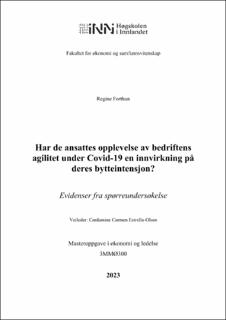| dc.contributor.advisor | | |
| dc.contributor.author | Forthun, Regine | |
| dc.date.accessioned | 2023-10-25T16:10:26Z | |
| dc.date.available | 2023-10-25T16:10:26Z | |
| dc.date.issued | 2023 | |
| dc.identifier | no.inn:inspera:144977596:147515000 | |
| dc.identifier.uri | https://hdl.handle.net/11250/3098742 | |
| dc.description.abstract | Denne oppgaven tar for seg temaene bytteintensjon og agilitet i organisasjoner. Målet med oppgaven har vært å undersøke faktorer som påvirker ansattes bytteintensjon, og om deres opplevelse av agilitet i organisasjonen under Covid-19 har en innvirkning på denne. Studien baserer seg på tidligere forskning av bytteintensjon som har anerkjent jobbtilfredshet og jobbforpliktelse som to av hovedindikatorene for bytteintensjon, samt forskning på agilitet i organisasjoner. Oppgaven tar også for seg jobbforpliktelse og jobbtilfredshet forankret i, blant annet, Hackman og Oldhams jobbkarakteristikamodell.
Problemstillingen ble undersøkt med en kvantitativ tilnærming med spørreundersøkelse, hvor utvalget var voksne ansatte som hadde vært i jobben sin i to år eller mer på tidspunktet spørreundersøkelsen ble gjennomført. Dataene ble analysert ved hjelp av statistikkprogramvaren SPSS. Mens det fantes mye forskning på flere av begrepene i studien, viste det seg utfordrende å operasjonalisere begrepet agilitet under Covid-19. Dette kan ha påvirket resultatet av undersøkelsen.
Analysene viste at jobbforpliktelse og jobbtilfredshet hadde en negativ effekt på bytteintensjon, og at jobbforpliktelse hadde den sterkeste effekten av disse. Det ble ikke funnet en signifikant negativ sammenheng mellom ansattes opplevelse av bedriftens agilitet under Covid-19 og deres bytteintensjon da det ble målt sammen med jobbtilfredshet og jobbforpliktelse i en regresjonsmodell. Det ble heller ikke funnet en sammenheng mellom alder og ansiennitet når det ble undersøkt sammen med de andre variablene.
Selv om ikke alle hypotesene lot seg bevise er det fremdeles flere funn i undersøkelsen som peker på mulige sammenhenger. De noe lave korrelasjonskoeffisienter indikerer likevel at det kan finnes andre variabler utenfor modellen som kan være med på å forklare ansattes bytteintensjon. Oppgaven avsluttes med flere anbefalinger til videre studier på temaet, begrunnet i indikasjoner som ble funnet i analysen samt til tidligere forskning på bytteintensjon og agilitet.
Nøkkelord: Bytteintensjon, turnover, agilitet, Covid-19, ansatt, jobbtilfredshet, jobbforpliktelse | |
| dc.description.abstract | This study focuses on the topics of turnover and agility in organizations. The aim of the study has been to investigate factors that affect employees’ turnover intention and whether their experience of agility in the organization during Covid-19 has had an impact on this. The study is based on previous research on turnover intention, which has recognized job satisfaction and job commitment as two main indicators of turnover intention, as well as research on agility in organizations. The assignment also addresses job commitment and job satisfaction anchored in, among other things, Hackman and Oldham’s job characteristics model.
The study takes a quantitative approach with survey as the mean to collect data. The sample was adult employees who had been in their job for two years or more at the time of the survey. The data was analyzed using the statistical software SPSS. While it exists a lot of scientific research on several of the concepts in the study, it proved challenging to operationalize the concept of agility during Covid-19. This may have affected the result of the survey.
The analyses shows that job commitment and job satisfaction have a negative effect on turnover intention, and that job commitment has the strongest effect of these. No significant negative relationship was found between employees’ experience of the agility in their organization during Covid-19 and their turnover intention when measured together with job satisfaction and job commitment in a regression model. Nor was there a relationship found between age and tenure when investigate together with the other variables.
Even though not all the hypotheses could be proven, there are still several findings in the study that points to possible correlations. However, the somewhat low correlation coefficients indicate that there may be other variables outside the model that should be included when trying to explain turnover intention. The thesis concludes with several recommendations for further studies on the topic, based on indications found in the analysis as well as previous research on turnover intention and agility.
Keywords: Turnover intention, turnover, agility, Covid-19, employee, job satisfaction, work commitment | |
| dc.language | nob | |
| dc.publisher | Inland Norway University | |
| dc.title | Har de ansattes opplevelse av bedriftens agilitet under Covid-19 en innvirkning på deres bytteintensjon? - Evidenser fra spørreundersøkelse | |
| dc.type | Master thesis | |
